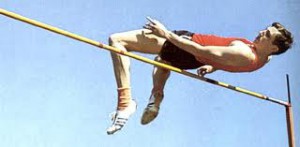There it is again. Weird works.

Fosbury’s own coach, who didn’t care for the move at all, called it “a shortcut to mediocrity.”
But it wasn’t, in fact, “unseen before.” Fosbury had been working on perfecting the technique for a couple years. Not only that, another athlete, the Canadian Debbie Brill, had developed an identical style she called the “Brill Bend.”
So how in the world did the lesser athlete Dick Fosbury not only develop a technique to best his rivals, but do so quite publicly while his competitors failed to recognize and adopt the innovation to excel?
The day Fosbury actually unveiled this new technique was five years earlier at a track meet in which he beat his own personal best by a foot and a half. Eighteen inches. High jump improvements are typically measured in inches – or fractions of inches. People should have been paying closer attention instead of ridiculing him. But why? Because it was new, because it was different, because it looked weird, and because no one else had the discipline to bother.
There it is again…curiosity, experimentation and persistence as keys to excellence.



